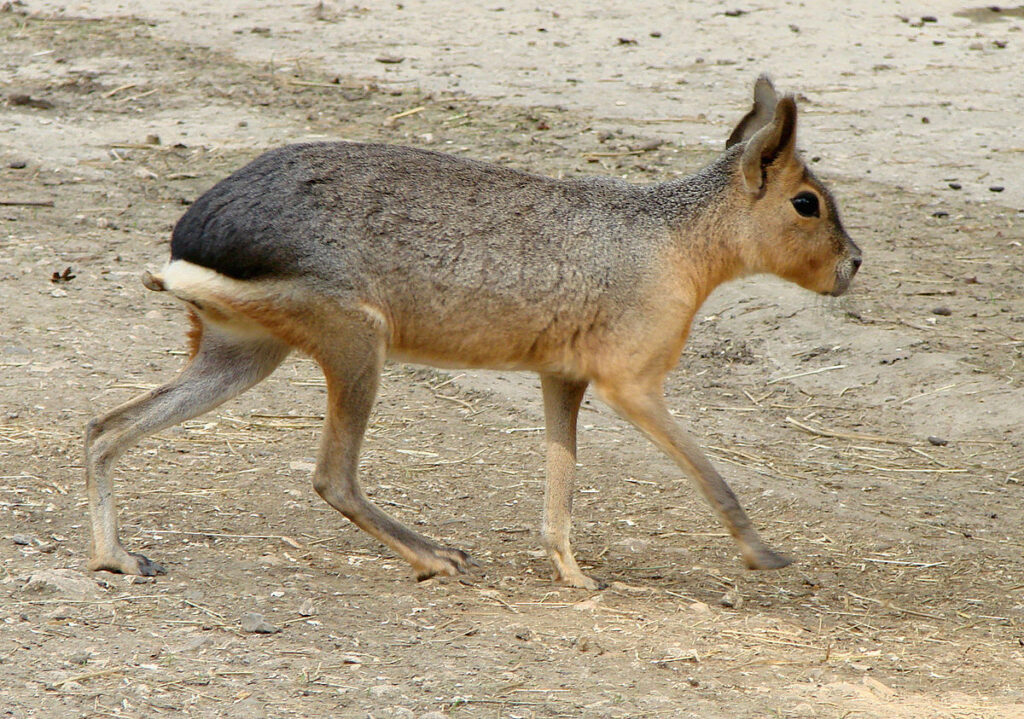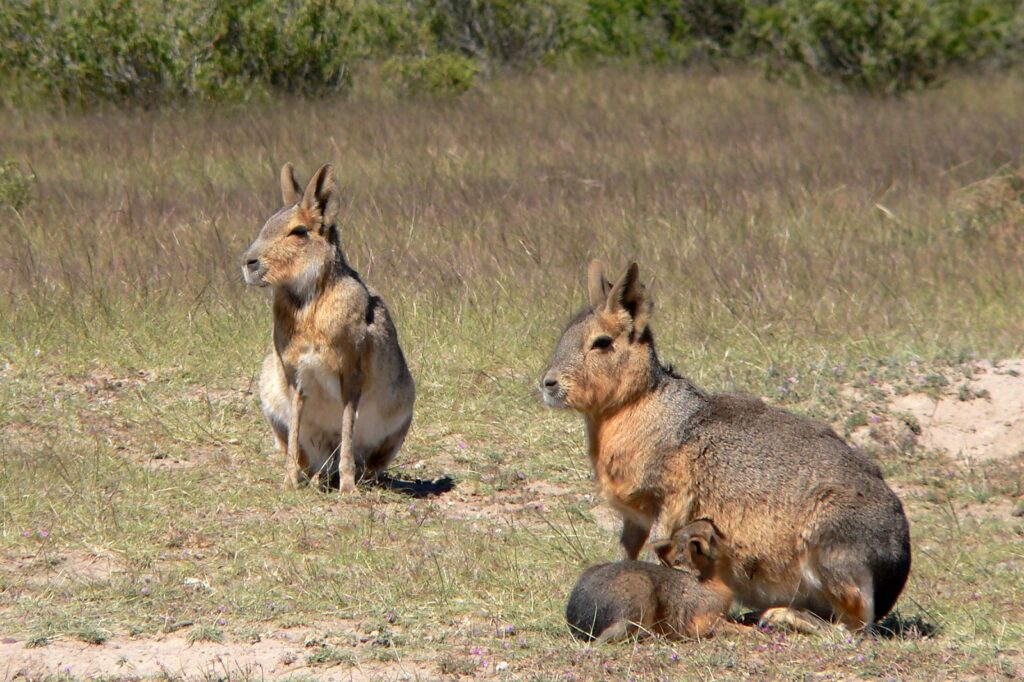The Patagonian Mara is a rodent of considerable size that is found only in the Argentine Patagonia. It is a monogamous species that has its burrow underground and feeds primarily on grasses. Its appearance tends to be confused with that of hares. To learn more about this rodent, we invite you to continue reading this article.

The Patagonian Mara
In the Patagonia region of Argentina lives an animal very similar to the hare, but what is certain is that it is a rodent that has a significant size. We are talking about the mara, an endemic, monogamous and herbivorous creature that, like dogs, usually sits on its hindquarters, with its forelimbs extended.
The mara, whose scientific name is Dolichotis patagonum, is a type of rodent of the Caviidae family, which is popularly known as the Patagonian mara, Patagonian hare, and Creole hare, although it is not part of the order of true hares (Lagomorpha). .
It is considered one of the largest rodents on the planet, with an average weight of 8 kilograms that can reach up to 16 kilograms. It is one of the mammals typical of Argentina that, in addition to being large, has long and strong legs that it uses to run very quickly when it feels persecuted.
Physical characteristics
A simple description of the Patagonian mara serves to get an idea of its physical features:
- Long: from 60 to 75 centimeters.
- Weight :: from 9 to 16 kilograms.
- Fur: thick grayish brown.
- Head: With volume and large eyes, long ears and a flat, round snout. The upper lip has a cleft.
- Extremities: thin. The later ones are more extensive than the front ones; and show four short toes on the front and three on the rear, as well as bulging pads for support.
- Glue: short and hidden by the fur. The tip is hairless.
Habitat
The mara resides in semi-arid and desolate plains of western, central, and southern Argentina where only thorny bushes, herbs, and thickets are present. Its distribution has decreased due to the modification of its habitat, particularly in the Pampas plain and in the coastal regions, due to the increasing urban development.
Social structure
Their social structure is defined by their monogamous situation, which is rare among rodents, since they mate for life, thus increasing their reproductive success. The pair comes to occupy a territory of about 40 hectares, their refuge is underground and they usually build it taking advantage of the abandoned nests that were previously dug by some species of Patagonian owls.
The male usually follows the female, protecting her from competitors and predators. Another concept of territoriality is unclear, but males appear to have a hierarchical dominance system.
The maras spend most of their time with their partner, going on tours as a couple. However, sometimes they move in large groups of 70 or more specimens in migrations to lake areas where food abounds. They are creatures that carry out their activities throughout the day.
Food
It is an eminently herbivorous species, since it feeds primarily on grasses and other herbs, and can survive without drinking water thanks to its metabolism.
Mating and Reproduction
To court their future mates, males have to put in a lot of effort to chase them for a long time. On their side, the females come into heat every quarter or four months. Maras usually give birth to 1 to 3 pups per litter, with three to four births each year and a gestation that can last up to 96 days.
The cubs develop in a community burrow, built by the maras themselves, although they can also recondition those abandoned by other animals; for example, the vizcacha. In such shelters up to 15 mothers can care for their litters.
They grow rapidly and can start feeding on grass within 24 hours of hatching. However, they remain in the burrow until they are four months old, meanwhile the mothers go there several times a day to breastfeed them. This lactation process can last for about 11 weeks. The breasts of these rodents are placed on one side so that they can suckle the puppies while sitting. That way, they don't neglect surveillance. After eight months, the mara is ready for a new reproduction
Life expectancy
In captivity, maras regularly live from 5 to 7 years, despite the fact that specimens have been known to live more than ten and a half years.
Maras in Captivity
Patagonian Maras are often bred in zoos or as pets, despite qualifying as a wild animal. Raised from birth, they are highly socialized with humans, and are bred well in captivity. Otherwise they tend to nocturnal activity to avoid socialization.
Conservation of the Patagonian Mara
The wild population has been declining despite the fact that the mara is not listed as a species under threat or at risk of extinction. All the provinces of Patagonia register it as a protected species. Its population decline is based on two main factors:
- Loss of its environment due to agricultural and industrial development and increase in human population.
- Food rivalry with European hares (Lepus europaeus), which were brought to South America by man.
The Argentine province of Mendoza decreed it as a provincial natural monument by law No. 6599 approved on May 12, 1998.
Some Peculiarities of the Patagonian Mara
Feeling persecuted, the mara can run quickly at a speed of about 60 kilometers per hour, being able to jump with great agility, which is why many value it as a hare. And it is that with a single movement it can move about two meters, for which it is helped with the nails of the hind limbs to obtain momentum. But, certainly, this huge rodent is more closely related to guinea pigs, popularly known as guinea pigs, since both species are part of the Caviidae family.
This animal also plays an essential role in the activity of Patagonian ecosystems. Being a highly mobile herbivore, it is vital for the process of seed dissemination over long distances, thanks to its faeces. As a relevant fact, the mara hardly drinks water, since it obtains the required hydration through the roots of the plants, which are an essential part of its diet.
An Endangered Species Chosen as a Pet
The Mara is included in the category 'Vulnerable by SAREM' (Argentine Society for the Study of Mammals). In addition to the usual predators of the mara (pumas, birds of prey and certain varieties of foxes), the biggest enemy it currently has is man. Reasons why humans place this species at risk include:
- Prolongation of urban settlements, planting and grazing.
- Illegal hunting.
- Occupation of its habitat by the European hare.
On the other hand, this rodent has adapted very well to life in captivity. Years ago it was common to see it in zoos, and it prowled without fear near the people who came to see them. For this reason, in numerous cases, the mara has been adopted as a pet.
We recommend these other items:



